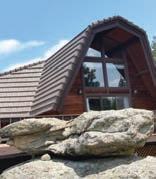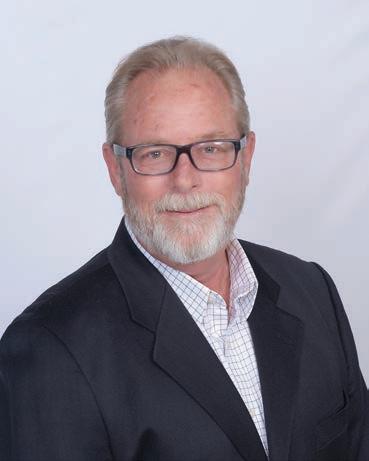












BY HALEY LENA
With a mixture of support and concern, the anticipated construction of the City of Lone Tree’s largest park, High Note Regional Park, has gained much community interest.
Lone Tree has partnered with the South Suburban Parks and Recreation District to construct a nearly 80-acre, multi-faceted regional park along Happy Canyon Creek, near Interstate 25 and RidgeGate Parkway.
“We obviously can’t t everything into this 80-acre park,” said Austin Good, Lone Tree’s assis-
tant city manager. “It’s a large park, but we’re not going to be able to ful ll all the community’s needs in it.”
Located between the RidgeGate Parkway Station and the Lyric neighborhood, the regional park is split into two halves. e south side is organized around an event/community space, with attention on natural elements. e north side focuses on the use of multipurpose sports elds.
e City of Lone Tree has invited residents to give input, and the ve multipurpose elds have raised concerns, including potential lighting and tra c issues, health and safety risks, environ-
mental impacts and that they won’t align with the natural feel of the park.
However, there are residents — such as parents of athletes and sports managers — who are excited for the new elds. Claiming there is a lack of sports elds in Douglas County, these residents said there is a demand for these elds as it is currently di cult to schedule games and practices.
It’s been a planned park space
A park has been planned to be built in the area for about two decades, starting in 2000 when Lone Tree residents voted to annex the RidgeGate area, which
included the idea for a future regional park.
It “has always been identi ed as a regional park,” Good said. e east side of RidgeGate was not within the boundaries of the South Suburban District, and in 2018, was incorporated so all of Lone Tree is within one park provider.
In 2020, Lone Tree and South Suburban began an initial study and planning e orts for the park and began taking public input the next year. Part of the input included a public survey in which more than 300 residents participated.
er more mental health help for
Bills tackle insurance coverage and cell phone use in schools
BY MONTE WHALEY MWHALEY@COLORADOCOMMUNITYMEDIA.COM
Legislation aimed at improving the mental health of Colorado’s children is gaining ground after garnering bipartisan support among lawmakers, say bill advocates.
“I think everyone is aware that there is a mental health crisis among our kids,” said Zach Zaslow, VP of Community Health and Advocacy at Children’s Hospital Colorado. “I think (lawmakers) are stepping up to be helpful in ghting this crisis.”
Zaslow, Dr. Lauren Eckhart, clinical director for the Colorado Springs division of the Pediatric Mental Health Institute at Children’s Hospital Colorado and about 100 parents, health care providers and primary care physicians were at the State Capitol to hail the passage of two key bills — HB 25 1002 and HB 251135. Both measures passed the State House and now are headed for Senate hearings before they are voted on by the whole legislature.
Zaslow said neither measure costs taxpayers but could likely save lives in the long term. HB 1002 tries to cut the disparities between standard physical health and mental health bene ts. e measure would ensure private health insurance carriers are not denying coverage for medically neces-
Regional Park,” said Grubb.
O
BY MCKENNA HARFORD MHARFORD@COLORADOCOMMUNITYMEDIA.COM
Douglas County is conducting a local transit study to assess the demand and cost of potential future services.
e county is considering offering three subregional routes between municipalities, circulator routes within urban areas and microtransit, modeled on the Lone Tree Link on Demand, which is a free shuttle service.
e county’s study found that two-thirds of daily trips are made within the county, suggesting local transit could alleviate trafc and assist commuters, older adults, teens and people who are disabled, said Zeke Lynch, Douglas County’s assistant public works director.
“We’re talking about how to serve the suburbanized and urbanized parts of the county,” Lynch said. “We’ve heard loud and clear from our stakeholders that an RTD or big bus system just doesn’t work and isn’t going to work in areas of our county, so we the locals are looking to better serve the needs locally.”
e county is already in the process of expanding microtransit into the Highlands Ranch area because of the success of the Link on Demand, Lynch said. e study estimates microtransit in Highlands Ranch would cost about $2 million annually and serve between 130280 riders daily.
e Denver Regional Council of Governments (DRCOG) has given $2.5 million to Douglas County to help fund the study and pilot programs.
Proposed subregional routes would connect Castle Rock, Castle Pines and Lone Tree; Highlands Ranch, Lone Tree and



Parker; and Lone Tree, Parker and Castle Rock. e routes would run every 30 minutes during peak times and every hour in non-peak times, six days a week, not on Sundays.
e subregional routes are estimated to cost between $1.8 and $3.2 million annually and serve between 280-540 riders daily.
Lynch said the county’s transit services would be more frequent and expansive than existing transit in the county, such as the Bustang service, which is looking to add a stop in Castle Rock on its Denver to Colorado Springs route.
Castle Rock town council members were not enthusiastic about the proposed transit services, citing the cost. e study estimates a Castle Rock circulator and microtransit services would each cost about $1 million annually.
“As long as Castle Rock doesn’t have to pay a dime, great, because it’s just not something that works here,” Councilmember Tim Dietz said. “My take is, people here love their cars.”
Dietz and Mayor Jason Gray
suggested the town would be better o investing in the Castle Rock Senior Center’s transportation program, which o ers rides to seniors and people who are disabled living in the southern part of the county.
Lynch said the county is working with the Castle Rock Senior Center and other similar services so that proposed services would build upon the current capacity of those programs.
Parker town council members expressed interest in potential microtransit services, but mostly wanted to continue to study the demand for circulator and subregional routes. A Parker circulator is estimated to cost about $1 million annually and microtransit services are estimated to be about $2 million annually.
“I think there’s room for subregional routes in the future, but I’d have to see the need,” Parker Councilmember Laura Hefta said. “A lot of people are still using their cars.”
Lynch said the study concludes in June and county sta will present the ndings this summer.
BY MCKENNA HARFORD MHARFORD@COLORADOCOMMUNITYMEDIA.COM
Douglas County state Sen. Lisa Frizell announced on Feb. 26 that she has been diagnosed with breast cancer.
Frizell, a Republican representing Senate District 2, shared the news on the oor of the Colorado Senate, saying she will continue her work in the Senate. Frizell said she shared her diagnosis out of respect for her constituents and her desire to be accountable to them.
“I want to be crystal clear that I will not stop ghting for the
good people of Senate District 2, while I simultaneously ght this new battle,” Frizell said. “I’m not going anywhere and I’m going to be ne.”
Frizell said her cancer was caught early thanks to regular screenings, and encouraged women to get annual mammograms for their health. e American Cancer Society recommends women without a family history of breast cancer get annual mammograms starting at the age of 45.
“Do it even though it is inconvenient and intrusive,” Frizell said. “Do it because it can save
Although public surveys asked residents about the need for the elds, Good said those surveys were only one of the many guiding factors when deciding on the number of elds and it was primarily South Suburban’s decision.
Also, a concept plan that included the ve elds was previously approved by the Lone Tree City Council and the South Suburban board.
e construction of the park will take place in phases. Crews plan to break ground late this year with the goal to have phase one open to the public in 2027.
As the city continues building new development in the eastern part of the city, it is hopeful that High Note Regional park will be a catalyst for the Lone Tree City Center, which will act as a new downtown to Lone Tree and aim to contribute millions in tax revenue each year to support public services, according to the City of Lone Tree website.
Additionally, more parks are planned to be built within the city, including a ball eld complex and a recreation center.
A major concern
Phase two of the project will add basketball and pickleball courts, outdoor tness equipment, a climbing area, a creek overlook,additional parking, a playground and three multipurpose turf elds on the north side.
Nathan Elliot, managing principal with OJB Landscape Architecture Firm for the project, said while thinking about the arrangements of the elds, it was thought to put a small green lawn in the center for people to relax or throw a football or frisbee.
He said the design team is working on amenities to support the green space and create more spaces around the north side of the park for people to sit and relax.
According to the 2022 South Suburban Master Plan, athletic eld usage “remains steady at 84% of desirable eld space” and that participation increased from 15,910 to 18,454 individual eld users in 2022. e number of elds is based on the population growth of the surrounding area, said Grubb. “ e initial phase of HIgh Note Regional Park’s development will meet the current level of service in Lone Tree while the additional elds will be necessary to meet the required level of services for the additional 30,000 residences anticipated in RidgeGate East,” Grubb said.
She added that of the 12 elds that already exist in Lone Tree, only four o er designated parking areas. e north side of the park anticipates to have 400 parking spaces — including electric vehicles and accessible parking spaces — to accommodate the elds. e elds can be used for soccer, lacrosse, volleyball and ag football among many uses.
A 2021 public survey showed that about 52% of residents preferred a nature walk, rather than a hammock garden, exible seating area, lawn chairs and nature-inspired features. To adhere to those wants, the park will have a one-mile walking loop, gardens along pathways and what designers are calling “Challenger Hill,” which will be similar to a small incline.
roughout the park is “ e Braid.” is will have interwoven paths that run the length of the park and will include seating, hammocks, cornhole, ping pong tables, re pits, public art and more, according to the city’s website.
e south side’s phase one elements include a festival terrace that will include an interactive water feature. Based on results from the 2021 public survey, about 34% of residents preferred a civic space with a water feature and were split on the type of water feature.
your life.”
Senate President James Coleman, a Democrat from Denver, thanked Frizell following her comments.
“We stand with you and we’re here for you,” Coleman said.
In a statement, Senate Minority Leader Paul Lundeen, a Republican of El Paso County, said Frizell is a “strong champion” and her colleagues have faith in her.
“Sen. Frizell is a ghter,” Lundeen said. “She wins for her constituents, she wins for the Senate Republican team, and we are con dent she will swiftly beat this personal challenge.”
A document sent to the Lone Tree Voice from the Committee of a Better High Note Regional Park, which consists of input from more than 50 residents, said ve elds is too many, considering there are sports elds also located at Dove Valley and Douglas County Heritage Park.
As South Suburban serves more than 151,000 residents across six cities and three counties, the district has 109 multipurpose elds, however, only 12 of those are within Lone Tree.
Becky Grubb, the communications manager for South Suburban, said that the ve elds at High Note Regional Park are to accommodate for the growing population in Lone Tree. “ e closest regulation eld for games within the district for Lone Tree is at David A. Lorenz
e south side will also have a food truck area, an amphitheater, a lawn with a “Bark Bar” for dogs and their owners, community porch swings and the base for a cafe around the perimeter of the lawn.
e north side elements include an interim dog park that will later be relocated to the south side, part of the north parking lot, restrooms, shade structures, maintenance and storage building, and two of the ve synthetic, lighted multipurpose elds.
Both the north and south side elements will also have connections to the Happy Canyon Regional Trail.
e city will be hosting another Friends of the Park meeting in May and the recent updates can be found by visiting tinyurl.com/High-Note-Park2025-update.
Assuming you have good credit and a sufficient income, getting a loan to buy a single family home is not that hard, but when it comes to buying a condominium, the loan may not be possible if the building does not meet some challenging Fannie Mae/Freddie Mac guidelines. Most loans are sold to one of those institutions, and they will not buy a condo loan from a lender if the following is true:
The condo development hasn’t been completed
Less than half of the units are owner-occupied (for investors)
The condo association you’re looking at may not have any of those problems, but if it has not completed the proper paperwork, it will still not make the list of “warrantable” condos.
money to buy a replacement home, that definitely doesn’t work.
Follow-up on Last Week’s Column


An individual or company owns more than 10% of the units within the building (including the developer)
More than 25% of units are delinquent on HOA fees
If the homeowner’s association is still controlled by the developer
Commercial space is 35% or more of the building’s total square footage
There are pending lawsuits against the condo owner’s association
The deductible for hail damage is greater than 5%
If there’s central heating, the master policy doesn’t cover the boiler.
Just last Friday one of our broker associates, Kathy Jonke, closed for a condo buyer who had to terminate her first purchase contract because it was discovered just before closing that the hail deductible was 10%. On the condo which closed last Friday, the lender thought the master insurance policy did not cover the boiler, but our inhouse lender, Wendy Renee, got the right person on the phone and was able to verify that the boiler was covered, and the closing took place on time. Such is the life of a strong buyer’s agent and a strong loan officer!
I’m not saying that you can’t get a loan for an unwarrantable condo. It’s just that you can’t get a conventional loan which the lender plans to sell to Fannie Mae or Freddie Mac. That’s true of all the big banks and big lenders, but small banks and credit unions are often “portfolio lenders,” meaning that they keep their loans in-house instead of selling them. Another option (rarely used) is for the seller to “carry” the loan, which can work for some but not all sellers. If the seller needs the
Another option is to get the mortgage from FHA, which has a Single-Unit Approval (SUA) option whereby they evaluate the loan on a case-by-case basis. FHA loans, however, require an upfront and ongoing purchase mortgage insurance (PMI) premium. Kathy’s buyer was given that option on her first condo purchase where the hail deductible was 10%, but she chose to terminate the contract rather than assume that added expense.
In any condo purchase, the lender will ask the condo association to complete a questionnaire and base its approval on the response. For example, in addition to the criteria mentioned above, the lender will want to know the association’s budget and its reserves.
Loans on non-warrantable condos can also require a larger down payment and carry a higher interest rate to compensate for the added risk. Recent increases in master insurance policy deductibles alone has made a higher percentage of condos non-warrantable, and loans on unwarrantable condos are estimated to equal over 22% of the market now.
If you are considering writing an offer on a condo, make sure your agent and loan officer submit the condo questionnaire immediately and ask questions about warrantability before spending money on inspection and appraisal.
NerdWallet.com is a trusted resource for consumer information, and, according to its 2025 Home Buyer Report, 62% of Americans believe that a 20% down payment is required to purchase a home. That’s the number one myth that is holding back Americans from pursuing the American dream of home ownership.
In fact, there are many programs, especially for first-time home buyers, which require zero down payment. Here in Colorado, the Colorado Housing Finance Authority (CHFA) has a website www.WhyWaitBuyToday.com, which describes their programs for both first-time and repeat buyers with 4% down payment assistance (DPA) up to $25,000.

To qualify for DPA, you have to have a credit score of 620 or higher. The deferred DPA takes the form of a second loan with a 30-year term and a zero percent interest rate. It accrues no interest, has no monthly payments, but is due and payable upon sale, refinance or payoff of your first mortgage. Some DPA is provided as a gift and does not have to be repaid.
Since, according to NerdWallet’s report, 33% of non-homeowners say that not having enough money for a down payment is holding them back from buying a home at this time, “this misconception could be stopping them unnecessarily.”
FHA is famous for requiring only a 3.5% down payment, but conventional loans are
available with as little as 3% down payment. Veterans with a “certificate of eligibility” can get a loan with zero percent down payment for a primary residence.
USDA loans with zero percent down are also available for rural properties.
Larger down payments are always better, and can avoid the added expense of purchase mortgage insurance (PMI), but once your equity reaches a certain level, conventional mort-
This column/ad appears in all the following weekly newspapers:
Arvada Press, Brighton Standard Blade, Canyon Courier, Castle Pines News-Press, Castle Rock News-Press, Centennial Citizen, Clear Creek Courant, Commerce City Sentinel Express, Denver Herald-Dispatch, Douglas County News Press, Elbert County News, Englewood Herald, Fort Lupton Press, Golden Transcript, Highlands Ranch Herald, Hustler 285, Jeffco Transcript, Littleton Independent, Lone Tree Voice, MetroWest Advertiser, Northglenn-Thornton Sentinel, Parker Chronicle, South Platte Independent, and Westminster Window
By listing your home with Golden Real Estate, you are assured that it will be promoted not only in The Denver Post and Denver Gazette versions of this column, but also in all 24 of those weekly newspapers.
gages allow you to eliminate that expense. FHA loans maintain that expense for the life of the loan, unless your down payment was 11% or higher, in which case you can eliminate that expense once you achieve a certain equity level based on an appraisal.
So, if this myth has been keeping you from pursuing home ownership, give us a call and we will help you achieve your American dream!
One of the articles, “Buyers Need and Deserve Professional Representation, But Here’s Why They Shouldn’t Have to Pay for It,” produced some feedback from readers. One said the percentages I quoted were wrong, and I’m embarrassed to admit that’s true. (Did I really go to MIT?) The numbers, however, were correct as was the logic of my argument, which is supported by the fact that virtually all closings taking place are ones in which the seller is still compensating the agent representing the buyer.
I confirmed that fact with one of the region’s biggest title companies. What that tells us is that sellers want one thing above all else — to sell their property. They have come to realize that they can try to avoid offering any compensation to the agent representing a buyer, but if they’re the only seller taking that stand, buyers will gravitate to other listings. Also, the standard contract to buy and sell real estate has a section in which it is stated what the seller will pay, so sellers are given the opportunity to accept that amount or call the buyer’s bluff and hope they come to terms. Closing data available to title companies suggests that sellers don’t win that argument often or at all.
One reader believes that if the buyer’s agent is paid by the seller, he’s not going to work to get the lowest price for his buyer. That would make sense, but in 22 years of being on both sides of transactions, I have never known a colleague or myself to do anything other than work in the best interests of a buyer he/she represents, not just in getting the lowest price initially, but when it comes to negotiating concessions or a price reduction based on inspection issues or a low appraisal. And when there’s a seller concession, many agents including ours, make sure our commissions are based on the net price.
$189,000
This nicely updated and well-maintained 574square-foot condo is in the Sable Cove subdivision southeast of Aurora’s Town Center. The address is 992 S. Dearborn Way, #7, east of I-225 and north of Mississippi Avenue. The seller, who bought it for a family member, updated everything in this ground level unit. It has luxury vinyl plank flooring throughout, a pantry with slide-out drawers, laundry hookups, and a wood-burning fireplace. There is lots of open lot parking for you and your guests. The HOA dues are only $255 per month and include water, sewer, maintenance, a community center, swimming pool and fitness center. There is a locked storage closet on the front porch, big enough for all your winter gear. Find more information, high-quality pictures and my narrated video walk-through at www.GRElistings.com, then call 303-525-1851 to arrange a private showing.





Dali Sun develops more accessible technologies for
BY TIM WEIGHART
SPECIAL TO COLORADO COMMUNITY MEDIA
It’s no secret that cancer is a di cult disease to research and treat. e notorious illness is almost undetectable in its earliest stages, and while there are e ective treatments, they are expensive and harmful to regular cells in the body. Cancer research has also hit multiple roadblocks due to a lack of accessible devices that can detect cancer cells.
Enter Professor Dali Sun of the University of Denver’s Ritchie School of Engineering and Computer Science. e researcher has used his multifaceted academic background to develop more accessible technologies for researching and treating cancer.
“Many scientists only focus on one eld,” Sun said, “but a lot of my research has bene ted from incorporating other elds of study. I’m always bringing in students from other elds to help with my research.”
Sun’s background in computer science was especially useful in the development of his new, smaller spectrometer that can detect cancer cells, chemicals and microplastics in concentrated samples. e device will be much cheaper and more accessible than the CD spectrometer, the only other device that can successfully detect cancer cells.
“ is is called an Elliptical Dichroism (ED) machine. We invented Elliptical Dichroism,” Sun explained. “While Circular Dichroism (CD) is the standard practice for molecular research, ED is actually the simpli ed version of CD.”
Dichroism is a practice that shades different molecules in di erent colors based on the molecules’ behaviors. Spectrometers are able to use dichroism by exposing molecules to light before analyzing their behavior over time.
While the lens used in CD spectrometers is perfectly circular, the elliptical — or oval-shaped — lens in Sun’s device is asymmetrical, which makes it easier for the spectrometer’s algorithm to analyze the molecules’ behavior and color them accordingly without the assistance of the CD’s more complicated operating system.
Sun’s rst ED spectrometer is smaller than a shoebox — at least three times smaller than the CD spectrometer — but he is currently developing an even smaller, cheaper model to be sold to labs, schools and hospitals in the hopes that the device’s visual representation of different molecules could increase the public’s understanding of molecular science.
“We are focusing on cancer detection and treatment, but the spectrometer itself could be a bene t to all labs,” Sun said. “Even at an elementary level, it could increase kids’ interests in the science and stem elds, which would bene t the (scienti c) community.”
Sun’s team plans to complete the smaller version of the ED spectrometer within a year before sending it to testers. Sun has also done extensive research on creating a much cheaper, side e ectfree cancer killer.
“We have found that a natural molecule has the ability to kill the tumor cells without introducing side e ects,” Sun said. “Most cancer treatments, chemotherapy, for example, introduce more side e ects than the therapeutic impact. ey’re not only killing the tumor cells but they also harm a lot of normal cells.”
e molecule, a speci c type of amino acid, could be mixed into water and drunk by cancer patients without causing any additional harm to normal cells.
However, Sun’s side e ect-free treatment still needs to undergo extensive research and clinical trials before being ready for distribution, something that will be di cult without pharmaceutical funding.
“It’s low-cost, so it’s not pro table for the pharmaceutical industry to produce this,” Sun said. “And since we’re using natural molecules, it’s not actually pat-


Associate professor Dali Sun, arriving at the University of Denver as a professor in 2023, has been researching cancer for 10 years.
entable, and the companies can’t put protections on it.”
As a result, the lab is turning to crowdfunding through DU to gain nancial support for their vital research. You can help support Sun’s research on a side e ect-free cancer killer by donating at this link and listing your giving priority as “Side-e ect Free Cancer Treatment.”
Cancer is still a deadly and mysterious disease, but if researchers like Sun can keep making promising progress on detection and treatment, it could become a more manageable illness in the years to come.
“Cancer is still a really severe clinical situation, and most new therapies are still in the developing phase. Our work could shorten that development,” Sun said. “I don’t think this research is in the interest of the pharmaceutical industry, but it is in the interest of cancer patients.”
























































































































































































BY CHAS SISK
A plan to write a key civil rights measure into Colorado law is running into intense resistance. Opponents say it’s really an attempt to rework how local elections are run.
e federal Voting Rights Act has been used for six decades to ensure the fairness of elections. But some worry the Trump administration will try to do away with it, so they’ve launched a national campaign for VRA protections to be written into state law. Several states have agreed.
Colorado could become the latest. Senate Bill 25-001 would give voters the right to bring discrimination suits at the state level and extend new protections speci c to the state, including making sure people can vote while in jail and barring discrimination based on gender identity or sexual orientation.
“ e right to vote is under attack by a federal administration testing the limits of its power,” said Julie Gonzales, a Denver Democrat sponsoring the bill. “Generations of brave activists, women, and people of color have fought for the right
sary mental health and substance abuse services that a healthcare provider has prescribed and that should be covered under the patient’s health plan, according to the legislation.
Advocates point to a report by health policy consultants Milliman that says that more than 75 percent of Coloradans with commercial insurance who have been diagnosed with a mental health condition have not received the care they need over the past year.
ere is still a “stigma” surrounding mental health and an associated reluc-
to vote — and now, it’s our turn. is bill would ensure that in Colorado, no matter your gender, race, or the language you speak, your sacred right to vote is protected.”
e measure has the backing of a wide variety of groups, including the ACLU, the League of Women Voters and Colorado Common Cause.
But many local o cials are worried — including some who say they would ordinarily support voting rights legislation.
“Aurora’s against the voting rights act?” asked Pete Schulte, the city attorney in Aurora. “I have to tell you, when I rst heard city council ... talking about opposing this bill, I was like, “Wait a minute. It’s the Colorado Voting Rights Act.””
“ is does not mirror the federal Voting Rights Act,” he added.
Schulte and other local o cials worry it could open new pathways for people to sue communities over elections. In particular, those suits could come over atlarge seats or the timing of elections. Both could be considered discriminatory, if someone suggests they suppress turnout or representation of people of color.
ey also point out that the state constitution gives Colorado communities
tance among most insurers to cover its treatment, Zaslow said.
at often translates to patients who need immediate treatment but don’t get the help they need until much later, Eckhart said.
“ ere are often signi cant delays that can hurt those in need. We need to get them to get care as soon as possible,” Eckhart said.
Cell policies required by 2026
HB1135, which also attracted bipartisan support, would require all school districts to have a policy in place dealing with cell phone during the day by July 2026. e bill does not impose a statewide ban on cell phone use in schools but calls for school districts the create their own local-
broad discretion to run elections as they see t. And, they say, cities in Colorado have successfully fended of any claims under the federal VRA that they’re violating voters’ rights.
“To date there have been no successful lawsuits against Colorado municipalities under the federal Voting Rights Act,” Heather Stau er, legislative advocacy manager for the Colorado Municipal League, said at a recent hearing on the proposal. “It’s very clear to us that the intent of this bill is to change speci c voting policies and structures of local government via litigation.”
e VRA’s supporters have tried to reassure cities that they don’t plan to come after them. But they say there should be laws to prevent election o cials from engaging in discrimination.
“We have these federal protections. ey’re nothing new. But they have been eroded,” said Michael Pernick, lawyer for the Legal Defense Fund who has helped draft state voting rights acts.






e measure has so far passed just one committee, in the state Senate. Backers say they hope to resolve local governments’ concerns as it moves through the process.

is story was made available via the Colorado News Collaborative. Learn more at https://colabnews.co


ly developed policy regarding cell phone use during school hours in K-12 setting, according to the legislation.
“We wanted to take a middle ground on cell phone use,” Zaslow said. “We don’t want an outright ban on their use, but we also don’t want a laissez faire approach to cell phones.”
Only about a third of Colorado’s largest school districts have a cell phone use policy during the school day. Local principals and teachers are then left to come up with their own classroom policies,

Eckhart said.
Clear evidence exists that social media use throughout the school day can have negative impacts on youth mental health and wellbeing, Eckhart added.
“It increases forms of anxiety and students who use their phones a lot are less inclined to get into physical activity,” Eckhart said.
And yet, cell phone use is “...tough pull to resist,” Zaslow said. “But maybe this bill will help us go in the right direction to help kids.”
BY SARA WILSON COLORADO NEWSLINE
Colorado lawmakers are running a bipartisan bill to set expectations for reporting misconduct in the state’s crime laboratories, an e ort that comes in the wake of revelations that a former forensic scientist allegedly mishandled thousands of DNA tests over her career.
“We are here because of due process and fairness — the idea that if a (Colorado Bureau of Investigations) employee sees data malfeasance going on, they have a duty to report and disclose, so that district attorneys can make a decision whether or not to act and whether it would impact their cases,” said Rep. Matt Soper, a Delta Republican sponsoring the bill.
He is running the bill alongside Rep. Yara Zokaie, a Fort Collins Democrat, Sen. Lisa Frizell, a Castle Rock Republican and Sen. Mike Weissman, an Aurora Democrat.
Former CBI scientist Yvonne “Missy” Woods was charged with 102 felonies in January over allegations that she manipulated DNA test results during her career. Prosecutors worry that over 1,000 cases could have been a ected by dubious evidence she processed.
“We never want to see something like this happen again,” Soper said. “We want to address some of the issues that have occurred here so that we have integrity back in our state lab.”
House Bill 25-1275 would require crime lab employees to report a wrongful action they witness to their supervisor within two weeks. at is de ned in the bill as an act from an employee that is a “gross deviation from the standard operation procedures.” e supervisor would then need to investigate the claim.
e CBI director would need to tell district attorneys about the alleged wrong action in a ected cases, and attorneys would need to notify defendants — and in some cases victims — if there was lab





misconduct in their case.
“Right now, there are defendants serving time who have no idea that the evidence used to convict them was handled by a crime lab employee implicated in misconduct. ere are victims who don’t know that the forensic evidence in their case may have been compromised,” Zokaie said.
e bill would also give defendants the ability to return to court if their conviction substantially relied on evidence subject to misconduct. e intent is that it would apply to cases a ected by the Woods scandal.
“All Coloradans have an interest in de-

conduct caused wrongful convictions,” said Jud Lohnes, a sta attorney with the Korey Wise Innocence Project at the University of Colorado Law School. “ e importance of forensic testing cannot be overstated. A single DNA result can a ect an entire criminal case.”


Sponsors hope to fast-track the bill. It was introduced Feb. 19 and assigned to the House Judiciary Committee but has not been scheduled for a hearing date. is story is from Colorado Newsline. Used by permission. For more, and to support the news organization, visit coloradonewsline.com.




BY NATHANIEL MINOR CAPITOL NEWS ALLIANCE
A bill that will soon be introduced at the Colorado legislature would allow Japanese mini vehicles on most of the state’s roads.
Kei cars and trucks, known as Kei-jidosha, or light vehicles, in Japan where most of them are made, are growing in popularity in the U.S. But many states have banned them in recent years, categorizing them as o -road vehicles un t for roads or citing safety concerns. U.S. buyers can import older kei vehicles that are exempt from federal emissions and safety rules for under $5,000.
Colorado’s Division of Motor Vehicles also tried to explicitly ban them last year, though it later pulled its proposed rule. Some kei vehicle owners, however, say the state is still trying to keep them o the road by refusing to allow them into the emissions testing process.
Now, proposed legislation could settle the issue of the tiny vehicles’ legality. One of the sponsors of the coming bill, Sen. Nick Hinrichsen, D-Pueblo, said kei trucks can be useful for farm work and in dense cities where space is tight.
Ad:”Where you need to parallel park, you need to get into narrow alleys, you need to get around tra c, hauling [construction] site stu , but to be able to do so with a vehicle that’s the size of a Mini Cooper instead of an F-150,” Hinrichsen said in an interview.





Hinrichsen and other advocates readily admit the micro vehicles, which have top speeds of around 60 miles per hour and can lack modern safety equipment like airbags, are not appropriate for the state’s
interstates and other major highways. His bill would restrict them from such roads, he said.
“But there’s absolutely no reason why they can’t be safely operated on city streets or on farm roads [or] state high-





















ways where the speed limit’s 55,” he said.
e bill already has the support of Gov. Jared Polis. A spokesperson said he is “excited to expand consumer choice to a ordable vehicles and looks forward to supporting kei freedom.”
Kei vehicles, however, have historically faced opposition from law enforcement agencies, motor vehicle administrators, and auto dealers.
Ryan Albarelli, a Broom eld software engineer, grew up wanting a truck. But as an adult with kids and bills, he could never justify the staggeringly high cost of a typical huge modern North American pickup truck.
en, on a trip to Japan, he noticed kei trucks and thought one of those might t in the sweet spot between utility and thriftiness -- brawny truck commercials be damned.
“It’s the opposite of a large masculine truck. It is a small, as weak of vehicle as you could possibly imagine,” Albarelli said. “But it’s a pickup truck and it’s cool
and people like it. So that enthusiasm is threatening to some people, I think, that sell vehicles.”
Albarelli eventually bought a 1990 Honda Acty once owned by a Japanese treetrimming company and powered by a tiny 660cc engine. He has to squeeze a knee past the steering column and his head is just inches from the roof. e top speed capable of coming from the three-cylinder engine is about 55 mph.
But the bed is just about the same size as the standard 6.5-foot bed on a new F-150.
“You’re not going to tow a camper with it,” Albarelli said “You’re not going to haul an entire bed of gravel with it to landscape your house. But brush or anything you pick up at the Home Depot or any hardware store is going to work.”
Albarelli was able to register and get permanent plates for the larger Toyota. e smaller Honda, though, is stuck in a bureaucratic doom loop. He said he got it















































































Tera Johnson-Swartz allegedly took a student o campus without permission
BY MCKENNA HARFORD MHARFORD@COLORADOCOMMUNITYMEDIA.COM
A Douglas County teacher is facing charges of kidnapping and contributing to the delinquency of a minor.
e Douglas County Sheri ’s O ce arrested Tera Johnson-Swartz, 44, on Feb.
titled through his county DMV o ce with no trouble. But his local emissions testing o ce has refused to test it, he said.
So Albarelli has revved up his advocacy work, publishing posts in a popular Facebook group and talking with bureaucrats and legislators. He even started a nonpro t, Colorado Kei Advocates, though he admits he hasn’t put much work into that yet. He hopes the legislature will legalize the vehicles so he won’t have to keep pressing people to let him drive it.
“I want to have a win-win situation,” he said. “I agree that we should have restrictions, but I also think that we should be allowing these vehicles.”
Colorado legislators have tried to legalize kei vehicles before. Failed bills were opposed by the Colorado Automobile Dealers Association and the Colorado
20 after she allegedly took a student out of school at the STEM School Highlands Ranch and o campus without permission.
Matt Cartiet, chief innovation o cer for the STEM School, said Johnson-Swartz worked as a high school teacher from 2022 until Feb. 14. Johnson-Swartz was a nalist for the 2025 Colorado Teacher of the Year award.
Cartiet said Johnson-Swartz was placed on paid administrative leave on Jan. 21 when the school was noti ed about the investigation, which denied her access to the school campus, electronic records and
State Patrol in 2015 and 2016.
Both groups declined to comment on the coming bill from Hinrichsen. But Tim Jackson, former president and CEO of the Colorado Automobile Dealers Association, said the arguments against legalizing kei vehicles at the state level boil down to two issues: pollution and safety.
“It does set up a two-tier system on both emissions and safety, and I think it contradicts everything that Colorado as a state has been trying to do,” Jackson said, referencing Colorado’s various e orts to improve road safety and clean up the state’s dirty air. Older kei trucks, including Albarelli’s Honda, lack modern systems like fuel injection that lower emissions.
e American Association of Motor Vehicle Administrators, a national group that represents and lobbies for motor vehicle and law enforcement administrators, has fought kei vehicles across the country for years. e organization did not respond to multiple requests for comment. Two senior o cials at the Colorado




students.
Cartiet said the school is “fully cooperating with authorities.”
According to Johnson-Swartz’s a davit, a student in one of her classes told police that Johnson-Swartz developed a relationship with them that started over text messages in December. e student alleged that some of the conversations included “intimate discussions.”
e student allegedly told police that Johnson-Swartz bought them cigarettes and marijuana and, on one occasion outside of school, Johnson-Swartz kissed them.
Division of Motor Vehicles and the State Patrol sit on the AAMVA’s regional board.
e Colorado DMV also declined an interview request. Asked why the DMV proposed and then pulled the rule explicitly banning kei trucks, spokeswoman Jennifer Giambi said in an email that the rule “aimed to clarify existing state laws regarding vehicle classi cations to ensure consistency and better understanding.”
“Kei Vehicles have never been eligible for on-highway title and registration in Colorado,” Giambi wrote, adding that the rule was pulled because it “was already covered by existing statutes.”
Albarelli, however, disputes that existing state law explicitly bans kei vehicles, pointing out that he was able to get temporary plates for his Honda and only got hung up in the emissions testing process.
e state’s Air Pollution Control Division declined an interview request, saying it does not comment on proposed legislation. A spokesperson, however, said the division, “does not have an ap-




e a davit states that on Feb. 18, Johnson-Swartz’s car was captured on a license plate reader and security cameras picking up the student from STEM School, leaving and then returning to drop the student o back at the school about 40 minutes later. e student allegedly told police that Johnson-Swartz drove them to a nearby parking lot where they talked about the investigation before going back to the school. e student’s guardians told police that they didn’t know their student had left and that no one had permission to take their student out of school, according to the afdavit.
propriate testing process for these kinds of vehicles.”
Josh Juhasz, president of Revhard Motors, a Denver-based dealership that specializes in Japanese models, said he’s imported a handful of kei vehicles for customers who’ve been able to successfully register them in counties where emissions tests aren’t required.
But, he said, state o cials have made the emissions process a “brick wall” and so he’s discouraged potential customers from buying kei vehicles — at least for now.
“I don’t see any reason why they shouldn’t be legal,” he said.
is story was produced by the Capitol News Alliance, a collaboration between KUNC News, Colorado Public Radio, Rocky Mountain PBS, and e Colorado Sun, and shared with news organizations across the state. Funding for the Alliance is provided in part by the Corporation for Public Broadcasting.














When we face struggles, it is easy to fall into a mindset of simple survival. at focus can become all-encompassing and often will prevent us from nding the road to thriving. In those moments, the expanse between “survive” and “thrive” can seem insurmountable.
Four years ago, I was given an opportunity to learn that the chasm between “survive” and “thrive” is only as wide as our mindset. Many of you who have been following Words of Encouragement from the beginning know that my work as a writer started when I was supporting a friend, Shane, who was battling stage-4 colon cancer.
In January 2021, Shane had taken a leave of absence from work to focus on trying to get better. I went to visit him during that leave, and as we sat and talked, he told me that the chemotherapy he was taking was making him so ill that he had decided to focus on the quality of his life, not the quantity.


He explained to me that he was stopping chemotherapy and that the remainder of his life span would be measured in weeks. As he told me of this decision, I began to tear up, and as the rst tear fell onto my cheek, he waved his hand in the way that only he could and said, “We are not going to do that; we are going to celebrate.”
With a lifespan remaining that could be


Tcounted in hours and pain growing in his body daily, Shane made a very conscious decision. He was not going to simply survive each remaining day; he was going to thrive.
Over the next few weeks, he went to watch movies in theaters that had been rented out exclusively for his extended family, had dinners xed by chefs who came to his house and attended a parade in his honor. He had the opportunity to

talk with friends, spend precious hours with his wife and daughters, and even play in a poker tournament at his house. It was inspiring to watch and learn from Shane during that time. e experience left me with the con dence to know that thriving is a conscious decision. It is both scary and empowering to recognize this reality.
When we understand that our mindset is the catalyst to thriving, then we are not
he 20 largest wild res in Colorado’s history all happened in the 2000s — nine of them between 2018 and 2020. Changing weather conditions such as ongoing drought expose the state to a much greater risk of a small spark becoming a devastating ame.
Just a few years ago, high winds fanned two small res into the Marshall re, which destroyed more than 1,000 homes in Boulder County. Similar conditions across the nation have made record-setting res increasingly normal, creating escalating threats to communities, ecosystems and economies. Faced with a tougher – and more ammable — environment than ever before, the re service must evolve alongside the threats it’s tasked with extinguishing.
Earlier this year, Colorado introduced Senate Bill 25-022, a forward-thinking bill that aimed to devote resources to developing AI tools for ghting res. It was a smart, proactive approach that recognized the potential of harnessing technology to do tasks such as analyze vegetation, predict an area’s wild re ignition potential and forecast the potential spread of an ongoing wild re. e bill was based on a recognition that traditional methods are no longer su cient in an era of climate-driven wild res.
While SB25-022, unfortunately, failed to pass, its introduction alone signals an important shift
in how we approach re ghting – from reactive responses with old equipment to proactive, data-driven strategies coupled with advanced tools. Traditional equipment and methodologies weren’t designed to handle the scale and intensity of today’s wild res. Integrating timehonored practices with cutting-edge technology can alleviate the immense pressure re ghters face on the front lines by freeing them to focus on the areas and tasks that need them most.
Future legislation around modernizing the re service can be the key to helping encourage the re service to adopt valuable new technologies. Fire ghters are often slow to embrace change, preferring the security and legacy of adhering to the tradition that de nes the re service for many. Linking the e ort to modernize the re industry with nancial incentives can o er reghters a compelling reason to reconsider familiar practices and tools.
Fostering a culture of growth within the re service is essential for both adapting to modern wild re challenges and attracting the next generation of re ghters. Moving away from the rigid, old-school rehouse mentality creates an environment where younger re ghters and fresh ideas can strengthen an industry that needs them more than ever. is shift is particularly important for recruiting Gen Zers, who overwhelmingly report that technological sophistication impacts
able to hide behind our struggle, satis ed with the idea that we made it through another day.
Don’t misunderstand me. Your struggle, my struggle, they are not easy things to navigate, but they are not insurmountable. e only thing that can keep us from thriving is ourselves. Shane demonstrated this in the most di cult situation possible, facing his own mortality.
When we take the time to truly look at the world around us, we will see we have front-row seats to watch insightful, heroic, and authentically brilliant moments in the human experience unfold before us.
Shane’s unwavering commitment to thriving is an example of this and gives me an invaluable reset button for when I nd myself stuck in survival mode. It is my sincere hope that you, too, can learn from this incredible model.
You have got this.
I hope my words encourage you, and that you will share them with those who need support. ank you to everyone who has shared their stories with me so far. I truly appreciate hearing about the valuable ideas you nd in these columns and how you use them to uplift those around you. You can reach me at jim. roome@gmail.com.
Jim Roome lives in Arvada with his wife Beth. He spent 34 years in public education. Lessons learned from the one two punch of being diagnosed with MS shortly before his best friend was diagnosed with terminal cancer led him into a new pursuit as a freelance writer and speaker. He uses his life experiences and love of stories to inspire, educate and encourage local, national and international audiences.

‘Ban’ term misses mark
Whenever we use language associated with book “banning” — or use words about book removal, prohibition, censorship, or denying access to books — we de ect from the real problem.
I found it interesting that the CPR News article regarding the current legislative debate to “protect school libraries from book bans” (which ran in the Feb. 20 print edition of the Lone Tree Voice) is missing the key. Only once did I read “developmentally appropriate” when the article quoted Boulder resident Erin Meschke.
I heartily align with Erin, who opposed the current proposed legislation. She said that “no one is trying to ban books. Rather, they are trying to make sure books are aligned with standards protecting children from pornography … the majority of books being challenged … graphically portray sex, pedophilia, rape, incest, and other things that have nothing to do with developmentally appropriate interest, education, or enlightenment.”
Indeed, “developmentally appropriate” should be the words we hear over and over, not “banning.”
As a compiling editor of ve literary anthologies for teens — and as a former literature teacher in
Iowa with gifted readers in grades K-12 (serving three public school buildings for elementary, middle school, and high school) — I developed supplemental classroom libraries by personally selecting over 2,000 books.
I never had a problem with parents objecting to the literature in my libraries because the books were always developmentally appropriate (e.g. “Catcher in the Rye” was not available in my elementary collection but was placed in the high school one).

If some books could be considered extremely objectionable, I left them for the public libraries rather than school libraries. ere’s a di erence between those two settings, and there are plenty of worthwhile books that can be included in school libraries. When I taught units that involved the possibility of literature that could be challenged, I always gave a written rationale to parents — and the appropriate principal — before starting the units. Communication provided transparency and allayed any possible fears. We wouldn’t feel the need to pass any legislation “protecting school libraries” if we had done a better job with our own adult discernment to protect young minds. Linda Mazunik, Lone Tree

State Sen. Larry Liston, a Republican from El Paso County, has carried a lonely torch during the last two legislative sessions. His bills that proposed to classify nuclear energy as “clean” in Colorado went exactly nowhere.
is year’s nuclear bill has a di erent look. It has four prime sponsors, two of them Democrats. And it comes after warnings about rapidly escalating electrical demand for data centers.
House Bill 25-1040 would allow nuclear energy to count toward Colorado’s clean energy goals of net-zero emissions by 2050.
Unlike Liston’s previous bills, it might even get approved. All ve Republicans in the House Energy and Environment Committee will likely support it. e committee chair, Alex Valdez, a Democrat and former solar developer, helped write the bill.
In public testimony, the other seven Democrats will likely be reminded that we have no long-term solution for safeguarding radioactive waste. ey will likely hear that nuclear plants remain extremely expensive. Georgia’s Vogtle nuclear plant was originally projected to cost $14 billion. It was completed in 2023 at a cost of $36 billion. Other nuclear projects have had similar cost overruns.
Some Coloradans also remember St. Vrain, the problem-plagued nuclear power plant south of Greeley. It operated from 1976 to 1989. Customers of Public Service Co. of Colorado, now a subsidiary of Xcel Energy, paid $1 a month from 1993 until 2016 to cover the $125 million cost of decommissioning the nuclear plant.
Legislators likely are hearing from Xcel’s lobbyists. It has two nuclear plants in Minnesota. e utility announced in October that it has models showing nuclear delivering 1,000 megawatts of electrical generating capacity within Colorado by 2035-37. at compares with the 750 megawatts of Comanche 3, the coal- red power plant in Pueblo that Xcel plans to retire before 2031.
A Pueblo task force created by Xcel and some local leaders in early 2024 reported that a nuclear power plant was the best replacement for the jobs and property taxes lost in the transition from coal. Craig, in northwest Colorado, has similarly been hunting for answers to replace jobs and tax base after the last coal plant closes in 2028.
Cheerleaders for nuclear usually ignore the costs. All of the technologies that will get us beyond 85% to 90% renewables have the same problem. eir gambles are smaller, though. In Wyoming, Bill Gates has invested in a rst-of-kind small modular liquid-metal fast reactor. If successful, these smaller modular reactors
their willingness to work at an organization. Embracing e ective change not only strengthens re ghting capabilities, it strengthens the pipeline of young professionals ready to tackle the next wild re.
Colorado’s attempt to integrate AI into wild re management may have stalled, but the idea behind it cannot be ignored. Investing in technology and advancing



would lower the nancial risks. e downside? Presumably, the tax base for Pueblo would potentially be far less.
Liston, a retired investment banker, told me he hopes for nuclear costs mirroring the declined cost of computing. at has a certain irony. e explosive growth of data centers being predicted provides a key argument for taking nuclear seriously. Xcel has told state regulators it projects need 1,923 megawatts of new generation — equivalent ot several coal- red plants — for large customers by 2031, with 70% of that coming from data centers.
How real will this demand be? And who bears the risks of investment in new and still expensive technologies?
I caught up with Dylan Roberts at a water conference. If adopted, the bill will “allow nuclear to be part of the conversation about Colorado’s energy future,” he said. “It doesn’t obligate the state nancially in any way. It doesn’t move anything forward as far as permitting or regulations. It would just say that if we get to a point where it becomes nancially viable and a private entity – along with local governments — buy in and they decide they want to pursue this, it would count toward Colorado’s carbon emission reduction goals.” Obviously, he added, conversations must also occur about security and waste.
A crucial di erence in this year’s bill — to be o ered as an amendment in the committee hearing on ursday — is a requirement that nuclear pay property taxes similar to coal and other energy producers.
Roberts pointed out that France gets 70% of its electricity from nuclear energy.
“As far as I know, nobody is scared of going to France,” he said. “ ey have found a way to do it and do it safely and responsibly. I’m not saying it has to be part of Northwest Colorado’s energy portfolio or the state’s portfolio, but at least it can be part of the conversation if a bill like this passes.”
I’m not sure that “love is in the air,” as one columnist concluded. Less-expensive opportunities may arrive in enhanced geothermal, for example. What we do have is sober discussion about the hard work of getting to zero emissions by 2050 while satisfying increased energy demands. at will be harder than closing coal plants by 2030.
Allen Best publishes Big Pivots, which chronicles the energy and water transitions in Colorado. For more on this topic, visit BigPivots.com.
re ghting strategies allows the industry to better protect communities and natural resources from the devastating impacts of wild res. Policymakers nationwide must take note and consider adopting new measures to safeguard both people and the environment. Wildres aren’t waiting for us to catch up — saving lives and property demands we get ahead of them.
Jason Cerrano is a 20-year veteran of re departments across the nation and the inventor of SAM, an automated water ow technology under the IDEX brand.


Dennis Taraborelli, our beloved son, and a brother, grandson, and nephew to others, passed away in his new home town, Ankeny, Iowa at the
























A publication of
Call first: 115 Wilcox St., Suite 220, Castle Rock, CO 80104
Mailing Address:
750 W. Hampden Ave., Suite 225 Englewood, CO 80110
Phone: 303-566-4100
Web: HighlandsRanchHerald.net
To subscribe call 303-566-4100 or Scan this QR Code

BROOKE WARNER Executive Director brooke@ntln.org
LINDA SHAPLEY Director of Editorial & Audience lshapley@coloradocommunitymedia.com
CHRISTY STEADMAN South Metro Editor csteadman@coloradocommunitymedia.com
HALEY LENA Community Editor hlena@coloradocommunitymedia.com
ERIN ADDENBROOKE Marketing Consultant eaddenbrooke@coloradocommunitymedia.com
LINDSAY NICOLETTI Operations/ Circulation Manager lnicoletti@coloradocommunitymedia.com
BUSINESS INQUIRIES
For advertiser or vendor questions, please email our business department at accounting@ coloradocommunitymedia.com
Columnists & Guest Commentaries
Columnist opinions are not necessarily those of the Herald.
We welcome letters to the editor. Please include your full name, address and the best number to reach you by telephone.
Email letters to letters@coloradocommunitymedia.com Deadline Tues. for the following week’s paper.
Highlands Ranch Herald
A legal newspaper of general circulation in Highlands Ranch, Colorado, the Herald is published weekly on Thursday by Colorado Community Media, 115 Wilcox St., Suite 220, Castle Rock, CO 80104.
Send address change to: Highlands Ranch Herald, 750 W. Hampden Ave., Suite 225, Englewood, CO 80110
Longtime journalist, arts advocate and Littleton community activist dies at 94
BY SCOTT GILBERT SGILBERT@COLORADOCOMMUNITYMEDIA.COM
Sonya Ellingboe, a longtime Littleton resident and beloved community activist widely known for her decades of writing about arts and culture in Colorado Community Media newspapers, died Feb. 22, 2025, at age 94.
Ellingboe was born Sonya Joyce Watson on July 9, 1930, in Columbus, Ohio, to economics professor Jesse Paul Watson and art instructor Elizabeth Joyce Watson. e little family moved soon after to Pittsburgh, where Ellingboe grew up and began her love of art and reading, in uenced by her parents and “a really super art teacher in high school,” as she recalled in a 2018 biographical interview with Colorado Community Media.
Ellingboe got her bachelor’s degree in visual art from Carleton College in North eld, Minnesota, where she met St. Olaf College student John “Jack” Ellingboe. ey married after she graduated from college and she then lived in Ames, Iowa while her husband got his doctorate in analytical chemistry at Iowa State University and the rst of their children was born.
e young couple wanted to live in Colorado, and Ellingboe recalled how a college connection helped her husband arrange an interview with Littleton’s Marathon Oil operation, where she said the company was “paying salaries in scenery.” ey moved to Littleton in 1956 and lived there except for a couple of years at the Marathon home o ce in Ohio in the mid-1960s. ey raised their four children in Littleton’s Aberdeen Village neighborhood before divorcing in 1981.
“I had four children in six years, which can tell you pretty well what my life was like,” Ellingboe said of her time as a busy young mother, but from her earliest days in Littleton she began her community engagement by joining the League of Women Voters, going to museums and classes, and creating pottery in a local studio “to talk to big people.”






work as a librarian, spending the next couple years with Je erson County’s Columbine Library.

Colorado Trust for Local News asks readers to make us aware of mistakes we may have made.
Email linda@cotln.org if you notice a possible error you would like us to take a look at.

Ellingboe’s love of reading was a big part of her life, which she shared with others by working as a librarian in Iowa in the 1950s until her rst child was born in 1955, and later by buying e Book House bookstore in Englewood’s Brookridge shopping center in 1970, then moving the store to a house on Littleton’s Curtice Street near Arapahoe Community College. “I moved it from Brookridge to an old house across from ACC, which had been a dream of mine from when we were in Ames, where there was a woman who had a bookstore in an old house,” she recalled.
Ellingboe operated e Book House until competition from chain stores led her to close the business in 1986. With her lifelong love of books remaining strong, she then returned to

In 1988, Ellingboe began her career as a writer, rst for the Littleton Times and then the Littleton Independent and its sister papers in the Colorado Community Media chain. Her writing career lasted 35 years until her retirement at age 93 in September 2023.
Even after health issues led her to retire, Ellingboe remained active in book clubs and kept a stack of books at hand to read along with e Denver Post, e New York Times and the Littleton Independent. She also continued to attend local artistic performances.
rough her years in Littleton, Ellingboe was active in many community organizations and cultural amenities and played a founding role in some. ey included the League of Women Voters, Bemis Library Fine Arts

Committee, Town Hall Arts Center, Littleton Business Chamber, Commission on Human Rights, Littleton Fine Arts Guild, Hudson Gardens and Event Center, Friends of the Library and Museum, Littleton Garden Club and Historic Littleton Inc.
“Most of the time we’ve been here I’ve been involved one way or another with something going on in Littleton … I get nostalgic about old things that get overwhelmed but I think we need to be changing and gaining,” Ellingboe recalled in the 2018 interview.
“I’ve been a joiner, I guess,” she added with her signature bright laugh. “I recommend it.”
Ellingboe’s career as an arts and culture writer was marked by the positivity and encouraging tone of her coverage. “Family is important to me, and so is making art accessible to as many people as possible,” she recalled. “I feel
my mission in writing stories isn’t to slam something, but to get people o their sofas to go see it.”
In December 2023, the Littleton City Council approved a Local Historic Landmark Designation for the house on Curtice Street where Ellingboe had her bookstore for many years, and in January 2024 the Littleton Arts and Culture Commission named Ellingboe as the rst-ever recipient of the City of Littleton Arts and Culture Award, with a ceremony honoring her held in March 2024. is year, the Littleton Independent received funding from the city’s Arts and Culture Grant Program to support coverage of arts and culture in Littleton and the south metro area, in honor of Ellingboe.
Ellingboe is survived by son John (Page Hartwell) Ellingboe, daughter Kirsten (Al) Orahood, daughter Karen (Peter Krasno ) Ellingboe and son Bruce (Cindy) Ellingboe; half-sister Anne Redmond; four nephews; nine grandchildren; and two greatgrandchildren.
No public memorial service is planned, as family members note their gratitude for the many celebrations of Ellingboe’s life while she was alive. Memorial donations in Ellingboe’s name may be made to Historic Littleton Inc., P.O. Box 1004, Littleton, CO 80160; historiclittleton@gmail. com; or to the arts organization of the donor’s choice.
“I hope I’m remembered as someone who encouraged people to participate in what pleases them,” Ellingboe said in the 2018 interview. “Getting involved in your community makes a huge di erence in how your life proceeds.”
She added: “Keep moving — that’s my other advice — as long as possible.”
Adecade in existence is no small thing for any event, so Colorado Dragon Boat and Denver Film are going all out to celebrate a decade of the annual Colorado Dragon Boat Film Festival
“It’s incredible to think that for the past decade, we’ve been bringing Colorado the only all-Asian and Asian American lm festival. We are beyond honored to hold this title and remain committed to continuing this vital work,” wrote Sara Moore, executive director of Colorado Dragon Boat, in an email interview. “It has been an intense labor of love, especially with limited sta ng and resources. But thanks to the dedication of our team and the support of our community, we’ve made it happen.”
is year’s festival runs from Friday, March 14 through Sunday, March 16 at the Sie FilmCenter, 2510 E. Colfax Ave. in Denver.
In addition to the top-notch local and international lms that center on uplifting the art and culture of the AANHPI (Asian American, Native Hawaiian, Paci c Islander) communities, the festival brings a wonderful array of extra-curricular activities. is includes receptions, a culinary experience, community conversations, Q&A panels and an Asian marketplace.
We visited with Moore and talked about the festival, what to expect and more. Interview edited for brevity and clarity. Tell me about this year’s theme? is year’s theme, “Honoring Our Past to Guide Our Future,” holds deep signicance for me, and I hope it resonates powerfully with everyone. One of the things I love most about our themes is that they are broad enough to invite interpretation and spark meaningful conversations. is year, the theme feels especially timely as we witness history repeating itself in ways we cannot ignore. e only way to truly move forward is to honor and share the stories of our past and to learn from them.
Tell me about this year’s lms?
I can’t contain my excitement about this incredible lineup of lms. If you asked me to pick a favorite, I honestly couldn’t, because they’re all my favorites. Beyond our incredible Film + Receptions and local showcases, we’ve curated a lineup that perfectly embodies this year’s theme.

What do you wish more people knew about the festival?




Reader
I wish more people knew that we are a small nonpro t with just two full-time sta members. As we celebrate our 10th anniversary, we re ect on the passion and dedication that brought us here. To continue hosting this one-of-a-kind festival, we need our community’s support. By uplifting and sustaining nonpro ts like ours, we can preserve and expand these vital cultural spaces for generations to come.
What do you hope people come away from attending with?
I hope everyone leaves this festival feeling the profound connection and love that lm, art and community can cultivate. Now more than ever, we need empathy and togetherness. As Coloradans, we are fortunate to be part of a community that not only embraces diversity but also fosters compassion and curiosity. Our state has long been a place where art and culture thrive, and it is this collective spirit that continues to uplift and unite us. See the full schedule and purchase tickets at www.dever lm.org.
Clarke’s Concert of the Week — Soccer Mommy at the Ogden Theatre
Sophie Allison (who records under the name Soccer Mommy) has perfected a blend of 90s grunge and indie rock with an appreciation of generational pop gures like Taylor Swift. Over the course of four albums, she’s brought listeners into her world for a moving look at her experiences and challenges. Last year’s “Evergreen,” may well be her best yet, a devastating record that cuts deeper than ever before.
In support of “Evergreen,” Soccer Mommy is coming to the Ogden eatre, 935 E. Colfax Ave. in Denver, at 8 p.m. on Monday, March 10. She’ll be joined by alternative singer/songwriter Hana Vu for an evening of indie rock sure to knock your socks o . Get tickets at www.axs. com.
Clarke Reader is an arts and culture columnist. He can be reached at Clarke. Reader@hotmail.com.



















BY MONTE WHALEY MWHALEY@COLORADOCOMMUNITYMEDIA.COM
Denver artist omas “Detour” Evans has planted his artistic footprint all over the Denver metro area, including the Arvada Center. His work creating the mural at the Center’s main gallery for all visitors to see and then displaying the nished product drew rave reviews from the Center’s visitors, said Collin Parson, Director of Galleries and Curator.
“Our visitors loved it,” Parson said via email. “It was an interactive piece that took the art of murals to the next level. Detour is an innovative artist who a few years ago was considered a ‘muralist’ but not as ‘an artist’ who happens to also make murals.”
“I’m proud of him and think he represents the quality and creativity of Colorado arts,” Parson said.
Evans could not be reached for comment.
Described as a painter, muralist and installation artist, Evans served as a Creative in Residence at the Denver Art Museum in the fall of 2017, exploring work that encourages a mixture of traditional art and interactive paintings. He has gained state and national fame for his mural and print creations that celebrate African American history as well as musical, civil rights and sports icons.
What may be Evans’ most acclaimed piece was recently unveiled before international travelers that streamed though Denver International Airport. e airport introduced Evans’ sculpture “It’s Not What You Take, It’s What You Bring Back” in its permanent public art collection in January in the Concourse B expansion area.


















“DEN’s participation in the City’s 1% for Public Art program is a point of pride for the airport. Many of the works in our permanent collection loom large in the memories and imaginations of our millions of annual visitors. omas Evans’ work, “It’s Not What You Take, It’s What You Bring Back,” will soon become an iconic xture of the world’s sixth busiest airport, welcoming or bidding farewell to our passengers,” airport CEO Phil Washington said in a news release. “I am so pleased to welcome Evans’ unique and vibrant sculpture to DEN.”
“It’s Not What You Take, It’s What You Bring Back” was inspired by the idea that life is always in perpetual motion and it’s our luggage that carries the items we hold dear. It was selected by a panel of community representatives, arts and culture professionals, and civic leaders in 2022, the news release states.
“I was super ecstatic to be selected to be a part of the process of adding art to such a vibrant place where millions of travelers pass through during their journey in life,” Detour said in the news release. e artwork, located on Concourse B East near gate B60, is 26 feet long by 12 feet wide by 8 feet high and suspended from the concourse ceiling. To help build the sculpture, Evans put a call out to the public for personal luggage that had a story behind it. at resulted in 183 donated bags that were incorporated into the nal design, including pieces from Cleo Parker Robinson, Ed Dwight, a ight attendant of 33 years, three DIA employees, as well as from folks with Denver’s ve professional sports teams.
Evans said on his webpage that the exhibit showcases the frenzied nature of modern life. “ e goal is to symbolize the 24/7 nature of both the airport and the journey of life, as well as memorialize the stories and experiences you gain when you travel,” Evans said.
Evans said that his fabricators, Demiurge, built a steel armature in six di erent sections that will serve as the backbone of the sculpture. Each piece of luggage will have its own plate extension that will be




“I was super ecstatic to be selected to be part of the process”


ans wrote on his webpage. .
e mural got statewide and national attention and was featured in e New York Times, the Athletic, the NBA’s social media accounts and several other media outlets, Evans said.
welded onto the armature.
For more information about the backstories of the donated bags and their donors, go to the airport’s arts page which opened for views this month. A time-lapse video of the installation can be found there as well.
e news release points out that the City’s 1% for Public Art Ordinance directs that 1% of any capital improvement project over $1 million undertaken by the city be set aside for the inclusion of art. At DIA, funds are set aside and then site-speci c large-scale public art opportunities across the campus are identi ed. For this speci c project, funding was designated by the Gate Expansion Program’s construction budget. No taxpayer dollars are used for any artwork at DIA.
Evans also explores ethnic identities through his African art display “ ey Still Live,” which mixes photography, DNA mapping and African objects, according to the Hu ngton Post. His prints celebrate Martin Luther King Jr., the music icon Prince and soccer legend Pele.
Evans also honored the 2023 NBA champion Denver Nuggets with a mural planted on the side of the building at 1919 E. Colfax Ave. Evans said he only created the mural to replace another that was in disrepair. However, “this mural evolved to be a beacon for the community because of the awesome year that the Denver Nuggets had,” Ev-

Evans drew plenty of local acclaim for his work at the Arvada Center. Evans used sound and interaction to draw patrons into his brightly colored creation at the Arvada Center’s main gallery, said the Arvada Center’s Parson.
Evans was part of a temporary exhibition titled “In Sight On Site: Murals,” Parson said. Working on the site at the Arvada Center as artist schedules allowed, visitors were able to see murals develop over a weekend, a week or even a month, he said. Evans contributed to a temporary exhibit at the Center so it was only displayed for a few months.
“Detour and artists like him use exhibitions like this to test ideas and concepts that otherwise might just be experiments in their studios,” Parson said.
He said that he donated a bag to the DIA exhibit, at Evans’ request. Parson said he was caught o guard by the request but suddenly remembered that his four-year-old daughter, Cora, had left her Kitty Cat purse in the back seat of Parson’s car.
“I knew she’d be momentarily upset, but I also believed she’d understand its signi cance when she was older,” he said.
“So I took the risk,” Parson said. “So far, it’s paid o . She’s forgotten all about the purse, and I can’t wait to take her to see her small but meaningful mark in Denver’s art history.”

BY ELLEN MAHONEY KUNC
You may have heard about the large underground seed vault in Svalbard, Norway, which opened in 2008. But you might be surprised to learn there is a similar facility in the Rocky Mountain region.
e National Laboratory for Genetic Resources Preservation in Fort Collins has been operating since the 1950s.
In 1958 the U.S. Department of Agriculture established the rst federal seed bank in Fort Collins to preserve valuable seeds for our food supply. It was opened during the Cold War and is sometimes referred to as a “doomsday” vault.
However, researcher Daren Harmel says their work goes beyond addressing apocalyptic scenarios.
“We get asked the question a lot about being some sort of doomsday vault or to be in response of some cataclysmic problem around the world. But that is absolutely not what this facility is designed for,” Harmel said. “ is facility was designed to support U.S. agriculture every day, as agriculture faces threats.”
e facility distributes plant and animal samples almost daily, or at least weekly, to support agricultural advancements.
Hannah Tetreault is the seed curator for the laboratory, which houses a large living collection used by research scientists and breeders. She helps oversee two long-term seed storage areas: a conventional vault freezer and a cryogenic vault.
“All of our seeds are di erent accessions and so they have di erent genes. And so, we here are preserving those by storing them in optimal conditions, testing them, and making sure that they’re alive so that



backup plans are crucial.
“We’ve talked about threats three or four times. Diseases, pests, changing weather patterns - it’s very important that research agencies like the Agricultural Research Service provide research and provide these genetic materials so that agriculture can stay ahead of all these threats,” Harmel said.
A threat, for example, would be an insect, like the aphid.
“ e U.S. wheat was a ected in the 1980s by a new aphid, the Russian wheat aphid, and it decimated the wheat crop,” said Tetreault. “USDA entomologists spent over a decade sorting through many seeds to nd two accessions of wheat seed coming from our seed bank that was found to carry a gene that had resistance to that Russian wheat aphid. And now that gene is being bred into a lot of our wheat cultivars.”
then we, in turn, are preserving all of that genetic diversity that exists in all of these di erent seeds,” explained Tetreault.
e specialized areas from where the seeds are freeze-dried, to the main storage freezer, to the cryogenic vault are all under careful lock and key and behind heavy metal doors. e huge conventional freezers store about 650,000 bags of seeds. Every bag has a bar code for database entry where Tetreault can locate a certain accession of seeds within the vault in minutes.
e seeds need to be kept alive at the right temperature and humidity. ey’re also carefully protected within the facility
Like our popular full-size Honeybells, Mini Honeybells are packed with rich avor and juicy goodness, but come in a size that ts in the palm of your hand. While “bell” is in their name and they’re part of the Honeybell family, Minis don’t always fully develop into a bell shape. But we can assure you they don’t lack in quality or taste! Rare Hale Honeybells are available in limited quantities for a limited time! Pre-order now to reserve your share of this year’s crop with this delicious deal!
from natural disasters.
“ ere was a great deal of engineering that went into designing and building this facility because we, as U.S. Agriculture, can’t a ord to have the samples in this building destroyed. And so, the designers did things like building a vault,” said Harmel.
From the outside, it looks like a regular building. But once inside you can tell it’s a bank vault with concrete, rebar-reinforced to withstand a tornado. It’s also designed to withstand the worst ood event that could happen while ensuring the samples are above that ood level.
When agricultural challenges arise,

e cryogenic vault holds genetic materials such as pineapple, avocado and lettuce in high-tech storage tanks. Amy Gurza, a biological science technician, lled one tank with liquid nitrogen to keep it at a frigid minus 260 degrees Fahrenheit.
From sun ower, wheat, rice, corn and tomato seeds to livestock DNA and tiny microbes, the Fort Collins gene bank helps safeguard agriculture.
“We use the word priceless a lot in our just normal speech,” explained Harmel.
“But very few things are priceless. e seeds and all the collections in this building are truly priceless.”
is story was shared via Rocky Mountain Community Radio, a network of public media stations in Colorado, Wyoming, Utah, and New Mexico, including KUNC.
plus
&




Thu 3/13
Low�ve @ 6pm Roxy on Broadway, 554 S Broadway, Denver
Kill Safari @ 9pm
The Church Nightclub, 1160 Lincoln St, Denver
Fri 3/14
Candlelight: A Tribute to Coldplay
@ 4:30pm / $29
Kirk of Highland, Kirk of Highland - 3011 Vallejo St, Denver. fever@eventvesta.com
Chris Koza
@ 6:30pm
Rocker Spirits, 5587 S Hill St, Littleton

Wild Love Tigress @ 7pm

Denver St Patrick’s Day Bar Crawl & Block Party - 10+ bars! @ 12pm / $14
Improper City, 3201 Walnut Street, Denver. events@nasstive.com




The Alley, 2420 W Main St, Littleton

Duncan Coker: Moe's Original BBQ @ 7pm
Moe's Original BBQ, 3295 S Broadway, Englewood

HOME @ 8:30pm Dazzle Denver, 1080 14th Street, Denver
Sat 3/15
Dry Ice @ 6pm
Hi-Dive, 7 S Broadway, Denver
Greybeard: R.A. The Rugged Man with Special Guests
@ 8pm
Bar Red, 437 W Colfax Ave, Denver

Potcheen @ 4pm
Denver St Patrick’s Day Bar Crawl @ 12pm / $18.89 The Passport, 1437 Market Street, Denver. info@pubcrawls.com
Sun 3/16
Adam Bodine @ 9:30am Dazzle Denver, 1080 14th Street, Denver

What The Dance: ST. PAT’S HOUSE PARTY - EDM + HOUSE NIGHT @ 3pm Larimer Lounge, 2721 Larimer St, Den‐ver

James Grebb @ 3pm Larimer Lounge, 2721 Larimer St, Denver
Collin O: Sober Art Show @ 4pm D3 Arts, 3614 Morrison Rd, Denver
DAYTRIPPER @ 6pm Lost Lake Lounge, 3602 E Colfax Ave, Denver Shepherd @ 7pm Lost Lake Lounge, 3602 E Colfax Ave, Denver

Tue 3/18
Beyond Laser Light Experience @ 3pm Denver
Abbath @ 5:30pm Summit Denver, 1902 Blake Street, Denver
Unotheactivist @ 6pm
Marquis Theater, 2009 Larimer St, Denver
High Country Dance @ 6pm / $16.51 Stampede, Aurora
Paolo Angeli @ 6pm
Mighty Fine Productions, 5235 38th Ave, Den‐ver
Wild Goose Saloon, 11160 S. Pikes Peak Drive, Parker
Mon 3/17
Modern Swing Mondays 2025 @ 5:30pm / $16.51 Stampede, Aurora

Hannah Connolly @ 6pm Mercury Cafe, 2199 California St, Denver
Wed 3/19
Zang Mansion Tour @ 3:30pm / $30
Mar 19th - Apr 9th
Zang Mansion, 709 N Clarkson St., Denver. asalutz@historicdenver.org
Tatiana Eva-Marie @ 6pm
Dazzle Denver, 1080 14th Street, Denver
Bad Knees @ 7pm Globe Hall, 4483 Logan St, Denver
Thu 3/20
Jeff Crosby: St. Patrick’s Day at Star Bar @ 7pm Star Bar, 2137 Larimer St, Denver


Rachel Platten: The Set Me Free Tour @ 7pm
Gothic Theatre, 3263 S Broadway, En‐glewood


Eric Golden @ 5pm

Alpha Charlie's Tap & Tavern, 6631 S Peoria St Suite 100, Centennial Clem RockZ: Live Littleton CO @ 6pm
The Toad Tavern, 5302 S Federal Circle, Littleton VNDETTA @ 6pm
Larimer Lounge, 2721 Larimer St, Denver
Jauz (18+ Event) @ 9pm
The Church Nightclub, 1160 Lincoln Street, Denver

Cherity Koepke introduces schoolchildren to art form
BY MARC SHULGOLD SPECIAL TO COLORADO COMMUNITY MEDIA
Ask any kid to take their pick: opera or broccoli, and they’ll usually run and hide. Cherity Koepke will step in and steer them to opera — and win every time.
As director of education and community engagement for Englewood-based Opera Colorado, she has sent portable, scaled-down versions of operas to various Front Range schools since 2008, charming the dickens out of thousands of school kids. And none of them left asking for broccoli.
“ ey love it,” Koepke said of her young audiences. “ ey cheer, they yell `Bravo!’ We taught them to say that. Some went out singing the tunes and dancing.” ese programs are one part of Opera Colorado’s activities, far removed from its performances at the Ellie Caulkins Opera House in downtown Denver. Before COVID struck in 2020, Koepke’s programs averaged an annual attendance of 45,000. A number of factors contributed to a recent drop down to around 25,000. As Koepke pointed out, “that’s more than the attendance for the main-stage productions.”
So, who are her audiences? “We take opera anywhere now, wherever we’re asked,” she said, discussing the program’s 40 annual visits, running from late September to the end of May. Host venues are charged $600, with scholarships available. Sponsors include Genesee Mountain Foundation and individual donors.
“We have a high percentage of visits to inner-city schools, providing them with translations (of sung texts) and learning materials,” Koepke noted. “We’ll present these programs for kids with autism, ones who are hard of hearing. ese shows transcend everything.”
Each year, two operas make the rounds. For 2024-25, Humperdinck’s “Hansel and Gretel” and Rossini’s “Barber of Seville” receive reduced treatments, performed by a cast of six with piano accompaniment.


Opera Colorado will present an hourlong version of Humperdinck’s “Hansel and Gretel” at 10 a.m. and noon on Saturday, March 8 in the PACE Center, 20000 Pikes Peak Ave., Parker. Information: 303-805-6800 or parkerarts.org.
“ e thing about `Hansel and Gretel’ is that it’s so much fun to watch,” Koepke reported. “ e kids giggle. When they hear that rst high note, they put their hands over their ears — but then they get used to it.” Most of her audiences consist of thirdand fourth-graders.
Koepke stressed that her job doesn’t stop with putting on mini-operas. She organizes two eld trips each year, where school kids attend dress rehearsals in the Opera House. Plus, there are three or four workshops held backstage, where students learn about what goes into presenting a production. And the little ones are not left out. “We have Storytime Sessions for preschoolers in libraries, where we have a pretend bookshop with books that open up and start singing.”



All this is a perfect introduction to opera — without any of the intimidation. Koepke stressed that the mini-operas are not limited to the younger generation. In recent years, they’ve have been performed for older folks at retirement communities, such as Wind Crest in Highlands Ranch, where “Barber of Seville” was presented in January. In addition, shows open to the public have been scheduled, such as the two March 8 performances of “Hansel and Gretel” at the PACE Center in Parker.
Audiences aren’t the only ones bene tting from this program. e six singers, members of the company’s artist-in-residence program (managed by Koepke), are gaining experiences that can carry them through a lifetime in performance.
“Each year we receive around 520 applications from around the world,” she said. “We’ll boil it down to 120 live auditions and then choose the nal six. For them, it becomes a full-time job.”


ose six will sing in all 40 performanc-







es. e cast, pianist Oleg Bellini, plus cardboard sets and costumes travel in a van and perform in gymnasiums, cafetoriums or, in the case of Parker’s PACE Center, an actual theater.
For cast members, digging into a role for a whole season is priceless, Koepke emphasized. “Usually, an opera singer will arrive for rehearsals, do a few performances and then move one,” she said. “Not the case here. Plus, they get professional development, they get to be part of a team.”
Many have gone on to major careers, including bass-baritone Ryan Speedo Green, who’s sung leading roles with the

Metropolitan Opera.
But the biggest winners are the kids. “ ey begin to understand what’s out there in their community,” Koepke said. “ ey’re seeing what opera actually is — not some silly thing on TV. ey learn that it’s simply telling a story with singing. And they learn how to enjoy watching it. We tell them they can laugh and clap and cheer. It’s OK to have fun.” You can’t do that with broccoli.
is coverage comes courtesy of a grant from the Littleton Arts and Culture Program. As a matter of policy, funders exercise no control over editorial decisions.


























1. LITERATURE: Who lives at 4 Privet Drive?
2. TELEVISION: Which 1980s sitcom featured the Keaton family?
3. U.S. PRESIDENTS: Who was the rst American-born president?
4. COMICS: What is Deadpool’s profession?
5. AD SLOGANS: Which makeup company’s slogan is “Maybe she’s born with it”?
6. HISTORY: Which battles marked the beginning of the American Revolution?
7. INVENTIONS: e 1904 World’s Fair introduced which u y confection?
8. MOVIES: In which year were the rst Oscars awarded?
9. MEASUREMENTS: What does 1 gallon of water weigh?
10. GEOGRAPHY: What are the colors of the Italian ag?



Answers
1. Harry Potter and the Dursley family.
2. “Family Ties.”
3. Martin Van Buren, born after the Revolutionary War.
4. Mercenary.
5. Maybelline.
6. Battles of Lexington and Concord.
7. Cotton candy.
8. 1929.
9. 8.34 pounds.
10. Green, white and red.
(c) 2025 King Features Synd., Inc.

Help Wanted
Registered Occupational Therapist
In-Person Full-Time Registered Occupational Therapist for 2025-26 School Year
• OTR must have, or be eligible for appropriate Colorado licensure
• Work with Pre-12th grade students completing assessments,attending IEP meetings and providing direct & indirect services.
• Full Time Salary range: MA $53,615 - $59,215 PhD $58,465 -$64,465 for 186 days.
• Fully paid insurance including medical, dental and vision.
• Access to a company vehicle or mileage reimbursement.
• May be eligible for a loan forgiveness program!
• Flexible scheduling with the opportunity to complete some work from home.
• To apply for this position, please visit our website ecboces.org and click on the “Jobs” page, click on the job you are interested in & then click on the grey button “Apply Online”, located at the bottom of the job listing. EOE
• Questions contact Tracy at (719) 775-2342, ext. 101. EOE
Registered Occupational Therapist 3 day a week Registered Occupational Therapist or COTA for 2025-26 School Year! OTR must have, or be eligible for appropriate Colorado licensure. COTA must be registered with DORA.Work with Pre-12th grade students.PT Salary Range-OTR:MA $32,269 -35,529 PhD $35,079-$38,679 for 112 days. Part Time Salary RangeCOTA: BA $26,280-/$30,102 for 112 days Access to a company vehicle or mileage reimbursement. May be eligible for a loan forgiveness program!Flexible scheduling with the opportunity to complete some work from home. To apply for this position, please visit our website ecboces.org and click on the “Jobs” page, click on the job you are interested in & then click on the grey button “Apply Online”, located at the bottom of the job listing. Questions contact Tracy at (719) 775-2342, ext. 101. EOE
Software Development Engineer Senior CSG Systems Inc. d/b/a CSG has an opening for Software Development Engineer Senior in Englewood, CO. to research, design, and develop computer and software programs. Position requires a Bachelor’s degree in Computer Science, Computer and Information Systems, or related field, and 5 years of post-bachelor’s progressive experience in a related occupation. Position allows for 100% telecommuting. Position reports to company HQ in Englewood, CO. The base pay range for this position in Englewood, CO is $161,886 - $171,886 per year plus standard company benefits. To apply, send resume to USIRecruitment@csgi.com. Must reference job 21890.57.2.
Home for Sale Erin Adams Broker Associate Real Estate Sales Counseling Consulting 303-917-7870 erin@oldcountryre.com www.oldcountryre.com

Office Rent/Lease
Business/Psychotherapist office available for sublet immediately.
Set up as Psychologist' office but usable for many professions . Three days per week are available. You can rent two or three days/month.
Three rooms include (A) large office with L shaped desk, easy chair, sofa and play area. (B) four-chair waiting room(C) break room/extra desk for used to allow patient to sit and fill out paperwork (+frig/microwave). Clean bathrooms 25 feet away. Good parking. Third floor with good elevator. Just east of downtown Littleton.
$315../month for two days $410 for three
Text 303-808-4140 Or email psyedtest@gme100.com

Misc. Notices
WIDOWED MEN AND WOMEN OF AMERICA. A social club offering many exciting activities and life long friendships. Social hours for all areas of Metro Denver. Visit Widowedamerica.org for details In your area!

or 720-323-2173
Dental insurance from Physicians Mutual Insurance Company. Coverage for 400+ procedures. Real dental insurance - not just a discount plan. Get your free Information Kit with details! 1-855-526-1060 www.dental50plus.com/ads #6258
STRUGGLING TO HEAR?
Audien Hearing delivers crystalclear sound with affordable, invisible hearing aids. Starting at $189! Call Now: 888-760-1015
Medical
Attention oxygen therapy users! Discover oxygen therapy that moves with you with Inogen Portable Oxygen Concentrators. Free information kit. 1-866-4779045
Miscellaneous
COMMUNITY FLEA MARKET OUTDOOR
Every Saturday 8am-2pm Roller City 6803 West Alameda Call Rod 720-980-1585
Become a published author We want to read your book! Dorrance Publishing trusted since 1920. Consultation, production, promotion & distribution. Call for free author`s guide 1-877-7294998 or visit dorranceinfo.com/ ads
!!OLD GUITARS WANTED!! GIBSON, FENDER, MARTIN, Etc. 1930’s to 1980’s. TOP DOLLAR PAID. CALL TOLL FREE 1-866-433-8277
AGING ROOF? NEW HOMEOWNER? STORM DAMAGE? You need a local expert provider that proudly stands behind their work. Fast, free estimate. Financing available. Call 1-888-878-9091 Have zip code of property ready when calling!
Prepare for power outages today with a Generac Home Standby Generator. Act now to receive a FREE 5-Year warranty with qualifying purchase* Call 1-855948-6176 today to schedule a free quote. It’s not just a generator. It’s a power move.
Miscellaneous
DIRECTV Stream - Carries the most local MLB Games! Choice Package $89.99/mo for 12 mos Stream on 20 devices at once. HBO Max included for 3 mos (w/ Choice Package or higher.) No contract or hidden fees! Some restrictions apply. Call IVS 1-866859-0405
Jacuzzi Bath Remodel can install a new, custom bath or shower in as little as one day. For a limited time, waving ALL installation costs! (Additional terms apply. Subject to change and vary by dealer. Offer ends 3/30/25.) Call 1-844-501-3208



Doodle Puppies
Golden Doodles and Bernedoodles Home-Raised Heath Tested and Guaranteed Standard and Mini Size available Schedule a visit today! (970)215-6860 www.puppylovedoodles.com
Donate Your Car to Veterans Today!
Help and Support our Veterans. Fast - FREE pick up. 100% tax deductible. Call 1-800-245-0398















































































































































